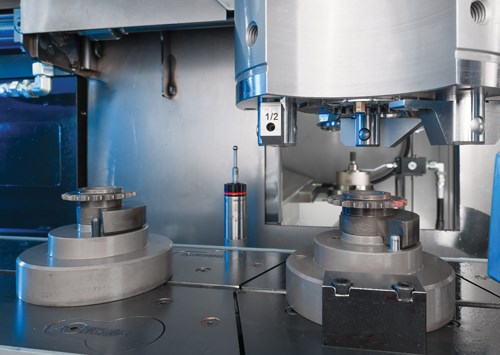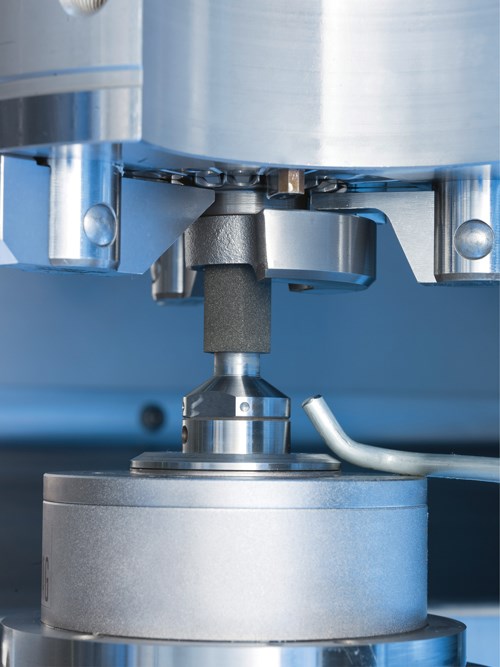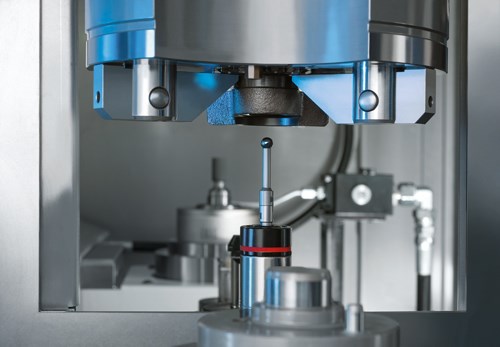Grinding in the Multitasking Mix
While different approaches to multitasking have been around for a while, shops often aren’t aware of many of the advantages these machines offer.
Multitasking operations bring two significant benefits to the machine shop. Traditional machining processes may call for two different operations to be machined on two discreet pieces of equipment, forcing the operator to face a potential stackup of machining processes, along with the demands of reliable clamping methodology, to maintain consistent quality. But combining operations in a single setup on a single machine allows better control of the datum structure, providing a smoother quality relationship between features.
A secondary benefit to multitasking is its effect on reducing cycle time. Again, discreet operations involve more total parasitic time for clamping, unclamping, loading and unloading that is truly non-value-added time. Multitasking allows the consolidation of those tasks to cut that time by as much as half compared with discreet operations.
From a builder’s standpoint, one of the biggest challenges of multitasking is making the machine configurable for multiple technologies. Lower budget machine tools fit the needs of many shops, but they do not necessarily allow for the flexibility of easily adding the building blocks of additional functionality such as a grinding spindle, a milling spindle or a turning turret. On the other hand, some machine platforms are designed specifically with this flexibility in mind, allowing additional discreet operations to be added without the need for a fundamental change in machine design.
Grinding and Turning
Two machining processes that are well suited to be combined in a single machine are turning/hard turning and grinding. When running parts on such a machine, the first step is to pre- or complete-machine all of the component surfaces that can be hard turned and then, without having to change the setup, finish grind all areas that require high-precision geometries. This process has two advantages. The turning process may be faster than grinding some surfaces, and wear and tear on the grinding tools is vastly reduced with only finish grinding operations carried out. And since the workpiece is machined in a single setup, the entire process is more efficient, without clamping errors and less time-consuming than when carried out on two separate machines.
One such machine that offers the benefits of the turning and grinding combination is the VLC 100 GT from EMAG. One of many multitasking machines offered by the company, it integrates EMAG’s pickup concept, where the main spindle is used to load and unload workpieces from the integrated loop conveyor or NC shuttle. The machining area can be equipped with a variety of turning and grinding modules. This compact system also includes integrated measuring that lends itself to improved component quality at a reduced cost per part.
The machine’s flexible configurability covers a range of applications. It can be used as a “conventional” vertical grinding center equipped with two grinding spindles for external and internal grinding, or it can handle combination machining, with an additional block toolholder for hard turning operations. The VLC 100 GT can be equipped with corundum or modern CBN grinding technology, and vitrified-bonded CBN grinding wheels can be dressed using a rotating diamond roll. A structure-borne sound system serves as GAP-control between the dressing roll and grinding wheel, and an adaptive process control system is included for short cycle times.
This machine is one of many multitasking machines that EMAG offers. “We’ve been offering this kind of technology with grinding and turning for many years,” explains Director of Sales Kirk Stewart. “But we also support customers with turn and mill solutions by using the same type of machine configuration, but adding the milling functionality in place of the grinding.” According to Mr. Stewart, a common workpiece that these turn/mill machines are used for is a carrier for automatic transmissions. This component has very tight tolerances on the pinion hole positions; the ability to both turn the ID and facing of the component as well as drill, semifinish and ream the pinion holes fits well in the capabilities of a turning and milling solution to achieve the typical quality and cycle time requirements. EMAG also offers multitasking configurations for turning and hobbing (the VSC 400 WF), which offers the possibility to pre-turn a gear and then hob it as well.
Consistent Control
All of EMAG’s vertical pickup machines feature a machine base of Mineralit polymer granite specifically engineered for its damping effect—8 times better than that of a cast iron base—contributing to higher surface finish of the components. According to Mr. Stewart, it’s this core construction of the machine bed that provides the necessary rigidity. “Each machine sits on a cast granite machine bed that allows it to have a much quieter vibration signature,” he says. “That reduced vibration signature, compared with a cast iron or a welded steel bed, allows for better tool life, better surface finishes, and better thermal stability of the system as a whole. Overall, it’s better suited for the more aggressive cutting forces inherent with hard turning, yet has the properties required for the finesse of grinding. When the tool is vibrating less, the process is more easily controlled for better performance in both turning and grinding.”
Also common among the machines, whether turning, grinding, or turning and grinding, is the use of a probe in the machine. In general, grinding is typically going to go hand-in-hand with tighter tolerances, so for these finish operations, being able to probe the workpiece while it is still clamped in the machine, within the same setup, is a definite advantage. The probe, while still protected from debris, is mounted between the automated pickup station and the work area and allows direct feedback to the machine so that the process can be controlled directly without either operator interface or expensive post process gaging. But Mr. Stewart points out that different tool management is used in the case of the grinding wheel. “We include adaptive grinding control, which consists of sensors to monitor the interface between the grinding wheel and the workpiece to define when the grinding cycle should start,” he says.
Applying the Technology
The quality of the VLC 100 GT may be best demonstrated by a concrete example, such as the machining of sprockets. Once the pick-up spindle has loaded the component, the integral internal grinding spindle carries out the first operation. Then the sprocket bore, with its small material allowance, is finish ground with CBN. The two block toolholders, also present in the machining area, then machine the back and front faces on the sprocket. The hard turning technology used for this operation not only results in short machining times, it also ensures that no subsequent operations are necessary. The measuring probe, located between the machining area and the loading station, now proofs the machining quality. The whole process takes less than 50 seconds in one clamping operation.
Most operations on these machines call for turning before grinding to remove the optimum amount of material for efficient grinding and overall cycle time. Occasionally, the grinding wheel may be used first for material removal as a primary function if flexible turning is required to create the final geometries such as multiple radii or chamfers throughout the profile.
Multitasking machines may also be targeted for lower-volume applications. The more technologies that are handled within a single machine, the longer the cycle time tends to be, and inherently, the lower the output. EMAG offers a much larger machine, the VLC 500 MT turning center, which provides a good example of low-volume multitasking operations. The machine offers a turret, a milling spindle with a tool changer and a grinding spindle. It meets the needs of turning with dedicated, robustly mounted tools, as well as milling operations independent of the turret, and grinding. “Our customers are machining components on the VLC 500 MT with cycle times of 30
to 40 minutes or more,” Mr. Stewart says.
Meeting a Need
While multitasking machines have been around for a while and continue to grow in popularity, they are still often not the first solution to come to mind when a shop is looking
to address a machining need. Mr. Stewart explains, “Even with customers who have been using our turning machines for a long time, when we refresh them on our entire portfolio and show them turn and grind machines or other multitasking machines, they’re sometimes surprised at these machine configurations. What is sometimes underappreciated is our ability to configure a machine with both the stability and precision required for grinding, yet the robustness and rigidity required for aggressive turning.”
The clear benefit of combining turning and grinding is the typical increase in quality made possible by combining finish machined features in one clamping versus breaking them up between the turning machine and the grinding machine. Optimizing the process is the other key. In many applications, the workpiece must be pre-turned before
the grinding process for material control. Being able to do the pre-turn work on the same machine provides for a collectively faster process.
While combining operations through multitasking
may sound like the ideal solution, it’s not the right process for every application. In some instances, geometries simply do not allow for only a single clamping to complete the part, and operations need to be broken into two setups. Requirements of each individual workpiece dictate the amount of flexibility in the choice of machine tool.
But overall, the transition from operating a turning machine or a grinding machine to running a multitasking machine that can handle both operations is usually relatively smooth. It is a standard machine that can be configured for each operation individually. “Any user who is already familiar with the inverted spindle type of configuration would feel very comfortable with our machines from the start,” Mr. Stewart says. “As far as the machine interface, navigation and any adjustments to multitasking, it really is transparent to the user. It’s quite the universal interface for both service and operators.”
Related Content
Precision Machining Technology Review: April 2025
Production Machining’s April 2025 technology showcase includes some of the latest technology from Sumitomo, Hurco, Supertec, SMW Autoblok, SW North America and Tungaloy.
Read MorePrecision Machining Technology Review: August 2025
Production Machining’s August 2025 technology showcase includes some of the latest technology from Big Daishowa, Greenleaf, The L.S. Starrett Co., Schwanog, Supertec and SMW Autoblok.
Read MoreShould You Bring Tool Regrinding In-House?
In some situations, the potentially high investment in an in-house tool grinding process can be justified with a relatively fast ROI. (Includes video.)
Read MorePrecision Machining Technology Review: February 2025
Production Machining’s February 2025 technology showcase includes some of the latest technology from Marubeni Citizren-Cincom, Murata Machinery USA, Mazak, Star CNC, Grob Systems and Schütte.
Read MoreRead Next
Hard Turning with Inverted Vertical Turning Centers
When it comes to the machining of hardened surfaces, hard turning is a particularly efficient solution that, compared with grinding, offers a radical reduction of machining times and investment costs.
Read MoreHow To (Better) Make a Micrometer
How does an inspection equipment manufacturer organize its factory floor? Join us as we explore the continuous improvement strategies and culture shifts The L.S. Starrett Co. is implementing across the over 500,000 square feet of its Athol, Massachusetts, headquarters.
Read MoreFinding the Right Tools for a Turning Shop
Xcelicut is a startup shop that has grown thanks to the right machines, cutting tools, grants and other resources.
Read More



























